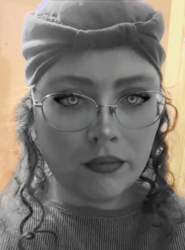Hi stitchers! I have a question for you, but I’ll provide some examples/context first. So, depending on your crafts of choice, hopefully you’ll be familiar with some of these.
First, the structure we most commonly know from (usually accidental) twisted knitting stitches. This same structure can be created through a technique called cross-knit looping, from the larger field of looping in general. And once more, it can also be created through the method of knooking. While the work is in progress, none of these techniques look anything alike, but the resulting structure is exactly the same, as seen here:

Second, the structure we most commonly know from the simplest form of tablet weaving. Each card/tablet holding 4 threads is spun, and in that process those 4 threads are plied into 1 thicker yarn. But at the same time, a weft thread is being fed between these plies, and locking each card’s yarn to the next:
 Well, this exact same structure can be created in reverse through a form (darning) of ply-spit braiding! Yarns that are already plied have their plies separated by a special tool, and a weft thread is fed through, connecting one to the next:
Well, this exact same structure can be created in reverse through a form (darning) of ply-spit braiding! Yarns that are already plied have their plies separated by a special tool, and a weft thread is fed through, connecting one to the next:

So finally my question to you: What other examples of this phenomenon have you observed? Textile structures that are generally identical, but created in wildly different ways. I really enjoy these and I’d love to hear about ones you’ve encountered in your crafting adventures!
Someone elsewhere once mentioned that linked double standard crochet stitches have the same structure as two-stitch wide rows of Tunisian simple stitch, except sideways! I haven’t looked into it enough yet though.

